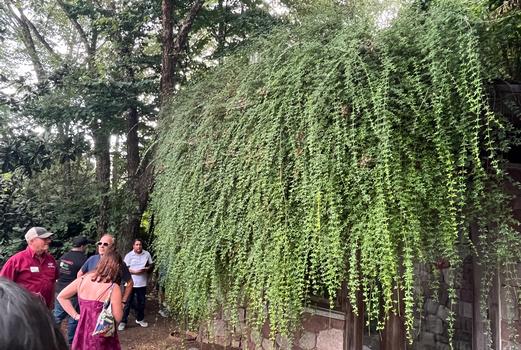Jasminum nudiflorum
Each week as the daylight hours grow longer, the temperatures warm, and the trees begin to unfurl their buds, we inch closer and closer to springtime. Insects are beginning their life cycles, early spring ephemerals are getting ready to burst open, and the Nursery is bustling with activity in preparation for the 2023 season.
A few months ago, in a past e-mail, we excitedly noted that some of our Jasminum nudiflorum crop had begun exhibiting sparse blooms far before its prime flowering time. Today, we’re revisiting this beautiful winter-bloomer and its full flush of February flowers.
Winter jasmine is a plant of many names, but is known by many as the flower that welcomes spring. In Chinese, this plant is referred to as Yingchun, which means literally “flower that welcomes spring”, as well as “Yinchunhua”, meaning “welcome spring blossom”. Botanically speaking, this plant’s specific name “nudiflorum” refers to the appearance of the flower prior to the opening of the foliar buds, leaving them exposed without protection or interference of leaves – literally, “naked flower” (nudi- naked; -florum flower). Early pollinators that find themselves awake due to warm winter days will benefit from the source of nectar when not much else is available.
While winter jasmine is native to China, it is widely considered naturalized in parts of the United States, particularly southern states like Texas, Georgia, Tennessee and Oklahoma, but also in the northern range of Maryland and New Jersey. It is likely that this plant is incapable of achieving invasive status due to its infrequent fruiting in cultivation, making it a low threat as to be spread by hungry birds or mammals. If the fruit does appear on the plant, it resembles a two-lobed blackberry. However, sightings of these fruits has been rare since winter jasmine’s inception as an ornamental plant in 1844 - Jasminum nudiflorum is largely deer and pest resistant, although it should be monitored for Japanese beetles in summer. Even though it tends to deter grazing wildlife, J. nudiflorum has no known toxicity in humans, livestock, or domestic pets, making it a well-rounded, and often underutilized, addition to garden sites that are begging for a climbing, trailing specimen.
Huge, impressive swaths of winter jasmine can be seen scrambling over stone embankments and walls where they are happiest, or trained vertically up trellises and pergolas for a twining effect. Branches can get up to 10’ in length if allowed to trail, and can be layered underground in winter in order to promote larger specimens and an expanded, sprawling form. The profuse yellow blooms that typically appear from January to March make excellent cut flowers in fresh, seasonal arrangements when paired with fluffy pussy willow catkins, ruby red Parrotia persica flowers, or sunburst-orange Hamamelis x intermedia ‘Diane’ blossoms. We have plenty of Jasminum nudiflorum available in 3-gallon containers ready for spring planting, as well as a future crop right behind it that is predicted to be ready by June. Make sure to check out our availability and get your winter jasmine ready this season to be in full spectacle by next winter!
BBC Studios. Jasminum nudiflorum. BBC Gardeners World Magazine. https://www.gardenersworld.com/plants/jasminum-nudiflorum/.
Breen, Patrick. “Landscape Plants.” Jasminum nudiflorum | Landscape Plants | Oregon State University. Oregon State University. https://landscapeplants.oregonstate.edu/plants/jasminum-nudiflorum.
Health Benefits. “Winter Jasmine Facts and Health Benefits.” Facts About Winter Jasmine. Health Benefits, October 10, 2021. https://www.healthbenefitstimes.com/winter-jasmine/.
Keener, Brian R. “Jasminum Nudiflorum.” Jasminum nudiflorum - Species Page - APA: Alabama Plant Atlas. University of South Florida, February 23, 2023. http://floraofalabama.org/Plant.aspx?id=5342.
Missouri Botanical Garden. “Jasminum Nudiflorum.” Jasminum nudiflorum - Plant finder. Missouri Botanical Garden. https://www.missouribotanicalgarden.org/PlantFinder/PlantFinderDetails.aspx?kempercode=a152.
NC Extension. “Jasminum Nudiflorum.” Jasminum nudiflorum (Winter-flowered Jasmine, Winter Jasmine). North Carolina State Extension. Accessed February 23, 2023. https://plants.ces.ncsu.edu/plants/jasminum-nudiflorum/#:~:text=This%20plant%20is%20native%20to%20Southeastern%20Tibet%20to,nudiflorum%2C%20means%20the%20flowers%20emerge%20before%20the%20leaves.
PFAF. “Jasminum Nudiflorum - Lindl.” PFAF Plant Search, 2010. https://pfaf.org/user/Plant.aspx?LatinName=Jasminum%2Bnudiflorum.
Seiler, John, Edward Jensen, Alex Niemiera, and John Peterson. “Virginia Tech Dendrology.” Virginia Tech Dendrology Fact Sheet. Virginia Tech, 2021. http://dendro.cnre.vt.edu/dendrology/syllabus/factsheet.cfm?ID=958.
Thompson, Paul. “Winter Jasmine.” Home & Garden Information Center | Clemson University, South Carolina. Clemson Cooperative Extension, February 14, 2022. https://hgic.clemson.edu/winter-jasmine/.
University of Delaware. “Jasminum Nudiflorum.” University of Delaware Botanic Gardens. College of Agriculture and Natural Resources. https://canr.udel.edu/udbg/?plant=jasminum-nudiflorum.
See all our Woody Ornamentals
At Grounds for Sculpture

